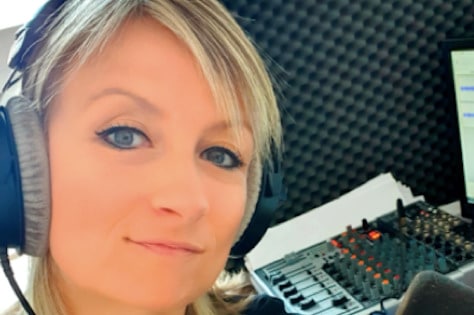After having broadcast from various radio station studios, they decided to create their own studio at home. Each day France-based Julie Keukelaere and Canada-based Jean-Marc Meis (aka Jihem), work as remote program hosts for several radio stations. They share their “cyber jocking” vision with RedTech.
RedTech: How do you become a voice track host?
Jean-Marc Meis: Firstly, by being a radio presenter. It would be difficult to do this work without being able to tick the live studio host box. Working in voice tracking means you always have to give the impression that you are “really” there. And that would be difficult to do without actually having that experience. I have worked as a station manager, working with studio hosts and voice track hosts. Thanks to the fact that I have worked on the other side of the fence, I understand what station managers expect in terms of adaptability and quality.
Julie Keukelaere: I started out in radio at 15 and attended the Studec studio school in Paris. But the beginning wasn’t easy. I remember people in the industry telling me I was “too young” and “inexperienced.” In 2011, my father was dying. That year Tropik FM on St Barts offered me a position as voice track host for one of its daily shows. That’s how I started out, with very little equipment, recording even on the day of my father’s funeral, because I didn’t want to let this opportunity slip through my fingers. I loved voice tracking right from the start because I was shy. It was easier for me than being in the studio surrounded by people and I somtimes get flustered.
RedTech: What are the challenges, advantages of remote working remotely?
JK: You have to be very thorough and carefully assess your workload, because some days everything will go well. Other days won’t and recording time for example will take longer. You must operate under live broadcast conditions and adapt your presenting approach to fit the station you’re working with. It’s also important to keep informed and provide content that will forge a relationship with the audience. Voice tracking is magic. It gives you complete control over your work hours! And also allows you to be more efficient.
JMM: Teleworking requires excellent organizational skills to ensure you don’t over extend yourself and that you remain effective. It also means spending more time keeping yourself informed about current events in the station’s target region. The advantage is of course being able to organize yourself the way you want. And, with zero commuting time, you can use those hours to be more productive.
RedTech: How does your typical day look?
JMM: I generally wake up at 5 a.m. I’m still a morning person! First, I concentrate on news gathering and capturing audio sounds to illustrate the news. Then on recordings. Those can be live reports, such as traffic news or audience participation in game shows. I finish my working day in the mid-afternoon. It’s a choice but personally I like starting early and finishing early. This allows me to be in tune with my clients’ hours, since we have a six-hour time difference.
JK: I don’t necessarily have a typical day, apart from Thursday, when I spend at least eight hours in the studio. A voice track career has allowed me to benefit from flexible working hours and to be able to incorportate other professional activities, Sometimes I start early in the morning or work until late in the evening. Every week is different and that’s important for me.
RedTech: Do you have to be self-disciplined?
JMM: Yes, of course, because working for several radio stations, you put yourself in the position of having to manage a number of deadlines. You also need to be disciplined in researching topics if you don’t want to be going around in circles. You should always have relevant contributions to make in terms of each radio station’s goals.
JK: There’s a risk of ending up on a work conveyor belt. You have to regularly listen to the station’s broadcasts to ensure you really do sound live. We always need to keep well informed, keep smiling and be aware that people are listening to you. And above all, have funt!
RedTech: What is the ultimate voice tracker’s toolkit?
JK: Good internet sites for little snippets of news, a smile in any situation, a calm approach and good equipment, to create good vibes.
RedTech: What equipment do you use?
JK: I work in a converted sound-proof room. As far as gear is concerned, I use a Shure SM7b super cardioid mic a professional DBX 286S preamp and a Behringer console with 24-bit multi-FX processor. My computer has two 24″ screens is equipped with with recording software.
JMM: My studio is a WhisperRoom double-wall sound-isolation booth. I use two mics, depending on requirements – a Neumann BCM104 and an Audio-Technica BP40. They are boosted by a preamp with digital sound processing from Symetrix. The whole thing is connected to an Allen & Heath XB14 console and a Focusrite Scarlett 8i6 sound card. In addition, I use a computer with recording cartridges and software, and two 24″ screens.

